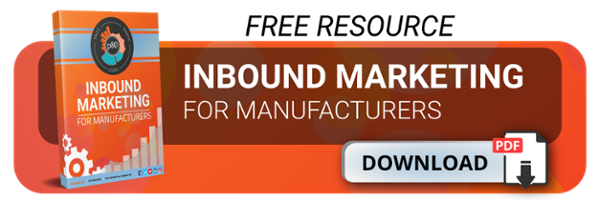Inbound Marketing Blog
for Manufacturers and Healthcare Companies
10 B2B Inbound Marketing Tips for the Dedicated DIY-er

When we approach an inbound partnership with a prospective client, they often ask: "Can we do some of this ourselves?"
Inbound is pretty flexible. Some of our clients rely on us for everything (and I do mean everything) while others prefer to keep their social media activities, blog writing, or premium content production in-house.
Do you fall in the second category? Or, do you want to try your hand at inbound marketing before committing to an agency? Here's what you need to know about DIY inbound.
Can I Do Some B2B Inbound Marketing Myself To Save Money?
First, here are the major components you'll need to see results:
- SEO
- Content Production
- Social Media Marketing
- Email Marketing
- COS & CRM Systems
- Conversion Rate Optimization
- Lead Nurturing
- Marketing Automation
- Analytics (Reporting, Interpretation)
- Strategy Optimization
As you can see, the skill sets needed to effectively execute inbound campaigns and grow lead volume are quite diverse. If you have people on your staff that can produce good content on a schedule, as dictated by a pre-defined inbound marketing strategy, you could do some inbound writing yourself.
***Content is usually the only thing we are comfortable sharing responsibility for. Content includes emails, social posting, blogging, premium content, website content, and other marketing copy. Technical items like SEO, CRO, analytics interpretation, and other optimization items are easy to mess up (and can have a negative impact on your business).
For content, the best solution is actually a mix. Double-down on content production, with some being done yourself and some being done through a partner. This will lead to much faster results.
Ultimately, you have to look at the traffic, lead, and revenue projections. Use those numbers to determine if saving a few bucks short-term will get you to your goals faster.
1. Know Your SEO
If you don’t put in the time to perfect your search engine optimization (SEO), the rest of your efforts will go largely unnoticed.
Getting good at SEO is a combination of knowing how search engines work and having the right tools. Check out these free SEO tools, and learn more about how you can improve your website’s SEO from this article.
2. Get Your Content On
Producing content is good for two reasons:
- You have the opportunity to answer your potential customers’ questions, educate them, and, if you’re lucky, entertain them, too.
- The more content you have on your website, the better your chances of ranking on Google.
Having a consistent blogging schedule is critical for keeping your readers interested while also bringing new people to your site.
A good cadence for blogging is once a week initially, especially if you're starting from ground zero in terms of website traffic. This might seem like a lot of work if you’re the only one producing content, but you don’t have to wax poetic for 1,500 words every week. Longer content is great for SEO, but there can be a lot of benefit from concise, 500-800 word posts.
3. Everyone’s on Social
Posting on social media regularly can keep your brand in the forefront of your potential customers’ minds. When posting on social, think about:
- What kind of third-party content would my audience find valuable if I shared it?
- What other websites do my audience visit, and can I post something from them?
- Do I have graphics, videos, or other visual content I can share?
A social media post should be tailored to the platform. For instance, take a more professional tone on LinkedIn, and you can loosen up a bit on Facebook, Twitter, and Instagram. Keep posts short on Twitter and Facebook, but you can sprinkle in more detail on LinkedIn. Also, use hashtags that are relevant to your topics -- doing a couple minutes of research will reveal what hashtags your audience traffic.
One last thing: Post at the right time. You don’t want your posts to be buried, so learn when to share on social media for your industry.
4. Sending Some Emails
Sending marketing emails can be scary because as soon as you hit that big, red button, you’re starting conversations with hundreds, possibly thousands, of people.
Start out simple: Give your audience content you know it wants. Summarize some of your blog posts, link them, and provide your contact information.
As time goes on, become more attuned with the types of emails your audience responds well to.
Using email services like Mailchimp, Sendinblue, or HubSpot Email Marketing can help you break down the results of your campaigns while providing a simple interface for creating good-looking emails.
5. Managing Your CRM
A CRM is a customer relationship management software, like HubSpot. It’s a necessary software for organization and measurement as your traffic and leads grow.
A good CRM will provide you with multiple advantages and tools, including:
- Marketing automation
- Sales enablement tools
- Ticketing systems
- Customer service options
6. Conversion Rate Optimization
For starters, what’s a conversion?
A conversion is whenever a visitor to your website completes an action, like filling out a form, downloading a guide, or completing a purchase.
So, optimizing your conversion rate is key to bringing in more qualified leads. Typically, conversion rates are low; anywhere from 0.5-5% of visitors end up converting.
Mapping out what next steps you want your visitors to take and formatting your website to match that plan is the first step to improving conversion rate.
Develop calls-to-action -- offers for free e-books, consultations, and so on -- and make sure at least one is visible on every page of your site. By giving away these offers in exchange for the user’s contact info, you’ve added a new contact and raised your conversion rate.
7. Lead Nurturing
So now you’re getting good traffic to your website ... but what do you do with that? Nurturing your leads is critical for turning traffic into sales. When nurturing your leads, use these tools for the best results:
- Personalization tokens
- Segmented email campaigns
- Marketing automation
To learn more about the best lead nurturing strategy, check out this blog post.
8. Bring in the Robots
In the beginning, you might have time to follow up with every potential lead personally, but as you grow your business, that gets to be a pain.
Setting up marketing automation can improve responsiveness and take some of the work off your plate. Many mass email marketing services also have automation options.
Think about setting up email workflows that trigger when visitors fill out forms or click buttons on your site. This practice alleviates the number of emails you have to send manually when traffic starts to heat up.
9. Reporting and Interpretation
Process improvement comes from having the right kind of data, and knowing what to do with it.
In the early stages of your inbound marketing journey, you’ll want to keep track of your:
- Organic traffic
- Direct traffic
- Highest traffic blog posts
- Google rankings for relevant keywords
- Conversion rate
And based on this information, you can refine your strategy for the next quarter or the next year. Do more of what’s already working, and either drop or reassess the stuff that’s not working.
10. Continuous Strategy Improvement
When you start out with inbound marketing, a simple strategy is best. Create content, post frequently, engage your audience as much as possible.
But as you start to stockpile blog posts, you can see what kind of content has the biggest impact on your traffic. After the first few months, develop a strategy to follow up on your successes. Find new ways to use your most prominent keywords to bring more relevant leads to your site.
Above all else, inbound marketing is responsive, so adaptation is key to success.
Can My Existing Team Do Inbound Marketing?
If you have a full marketing team (not a one-person army) with experience executing online campaigns, it may make sense to do it yourself. Previous experience with the tactics is essential.
In this scenario, your team would work directly with your inbound agency and share responsibility for deliverables. An inbound agency is fully dedicated to ramping up your traffic, leads, and revenue. As long as the internal team can support their role independently (no hand-holding!), this scenario can work out well.
Like I mentioned above, doubling down on content production will speed results!
Can I Do B2B Inbound Marketing Myself To Learn Inbound?
You might be hoping for knowledge transfer so you can bring inbound marketing in-house at some point in the future. Partnering with an agency and doing some of the tasks is NOT the best way to invest in inbound or learn the ropes.
If this is your goal, there are many (much more affordable) inbound marketing training resources available. HubSpot is one of our favorites.
If building an in-house lead generation machine is what you need, awesome. Just remember - hiring all the necessary roles is exponentially more expensive than outsourcing to an experienced agency.
Bottom Line On Doing B2B Inbound Marketing Yourself
When you partner with an inbound agency, you're actually investing in the inbound methodology. While highly effective, inbound marketing is not an easy task - especially if you have no experience.
To see results in a reasonable time frame, you're better off using experts who know what they're doing and are proven to get those results. After all, we business owners love efficiency and ROI.
Learn more about how to up your inbound marketing game with our free guide!
Editor's note: This blog post was originally published in 2017 and has since been updated.
Our Blogs, Direct to Your Inbox!
How to Audit your Online Marketing
If you are executing digital marketing, congratulations! You are most likely already one step ahead of your competition, and making strides to meaningfully connect with prospects online. But, how do you know if you’re seeing continual success year over year, and improving your metrics?
Without the tools in place to analyze and benchmark your efforts, it is impossible to scale your online marketing and ensure continuous success.

